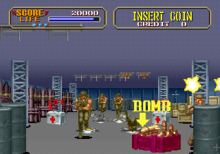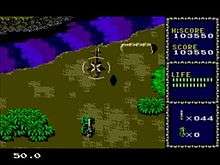Line of Fire (video game)
| Line of Fire | |
|---|---|
 Arcade flyer for Line of Fire (showing the cabinet) | |
| Developer(s) | Sega |
| Publisher(s) | Sega |
| Composer(s) | M.A |
| Platform(s) | Arcade, Amiga, Amstrad CPC, Atari ST, Commodore 64, Sega Master System, ZX Spectrum |
| Release |
Arcade: 1989 Amiga, Amstrad CPC, Atari ST, Commodore 64, ZX Spectrum: 1990[1] Sega Master System: 1991[2] |
| Genre(s) | Shooter |
| Mode(s) | Single-player, multiplayer |
| Cabinet | Sit-down |
| Arcade system | Sega X Board |
| CPU | 2x Motorola 68000 |
| Sound |
Yamaha YM2151 SegaPCM |
| Display | Raster, 320 x 224, horizontal orientation |
Line of Fire is a shooting video game, played from a first person perspective, and developed by Sega. The cabinet features two positional guns, and a design which allows the player(s) to sit down while playing the game. It was first released in arcades in 1989 before being converted to home computers and published by U.S. Gold in 1990. It was released on the Sega Master System in 1991; however, the style of the game was changed to that of an overhead scrolling shooter.
It follows a two-man commando unit as they try to escape from a terrorist facility after seizing a prototype weapon. The arcade game was praised for its graphics but criticised for lacking drama, and the home computer versions were criticized for "blocky" visuals, though reviewers found that there were some nice touches. The Sega Master System version was seen as disappointing.
Gameplay

The game sees the player placed a member of a two-man commando team who have been charged with going behind enemy lines to bring down a terrorist organisation which has access to a large arsenal of weaponry. During the mission the team find a "special weapon", which is a vehicle mounted, automatic machine pistol, and must report their findings. However, the player is faced with many enemy troops and military vehicles which need to be destroyed in order for the commando squad to escape in the jeep, and must use the "special weapon" against the terrorists.[3]
The game is played from a first person perspective, with two cabinet mounted, positional guns used the shoot enemies on the screen. There are eight stages which take place in various settings including the enemy base, jungle, desert and ruins.[4] At the end of each is a boss vehicle which must be destroyed to progress. Ammunition is limited to a few clips of bullets for the machine gun, a small supply of hand grenades and a screen clearing missile, although additional supplies can be obtained by shooting the relevant icon when they appear during play.[5]
The stages scroll both horizontally and into the screen is pseudo-3D, and due to Sega's dedicated sprite handling software the game was able to combine the two movements in a single stage, effectively turning corners. This revolutionary system allowed the player to experience a real 3D landscape.[6] Between stages a map screen is displayed which shows the player progressing through the terrorist facility and towards freedom.
Development

The Line of Fire arcade machine uses the Sega X Board hardware, comprising two Motorola 68000 processors running at 12.5Mhz as its CPU, and sound is reproduced using a Yamaha YM2151 sound chip. It features Raster graphics at a resolution of 320 x 224 pixels on a horizontally orientated monitor.[7] There are two different cabinets available for the game. One cabinet allows the player(s) to sit down as they are playing the game,[8] reaching forward to use the cabinet mounted light guns. The other is an upright cabinet with attached light guns.[7]
U.S. Gold acquired the licence to release the game on home computers, and versions were produced for the Amiga, Amstrad CPC, Atari ST, Commodore 64 and ZX Spectrum. The conversion for all five home computers was handled by Creative Materials and all were released in 1990.[1] For these versions there is no light gun support, instead the player moves a crosshair using a mouse, joystick or keyboard to target enemies, and pressing a button to fire.
A version was created for the Sega Master System in 1991,[2] published by Sega and developed by Sanritsu Denki. This version is very different from every other conversion as it is an overhead vertically scrolling shooter, although the storyline and locations are mostly unchanged.[9] The game does not feature light gun support, the player using the standard control pad. This game also features support for the SegaScope 3-D Glasses, a way of viewing the game in 3D, if the player enters a button combination when starting up the console with the Line of Fire cartridge inserted.[10]
Reception
The arcade game was met with a mixed reception. Zzap!64 praised the graphics but criticized the gameplay and lack of difficulty.[11] CU Amiga gave it an average review, calling it a poor clone of Operation Wolf, with graphics that "aren't as sharp" and lacking dramatic sound. There was praise for the sit-down cabinet, but this was the only lasting appeal found by the reviewer, although they found it a nice touch that defeated enemies stay on the screen rather than disappearing after a few moments, allowing the player to survey the scene they have just created.[8] Hardcore Gaming 101 praised the graphics, comparing its sprite manipulation to later first-person shooters and textured-mapped 3D polygons, but said the gameplay is "nothing spectacular".[12]
The home conversions received mixed reviews. The Commodore 64 version received a score of 32% in Zzap!64 magazine, with a lack of enemies on screen being a major criticism, although it was said that the attempt at 3D was impressive. The reviewers found the difficulty curve a problem, with level one being too easy and too long, followed by tougher later levels.[13]
The Amiga version was more well received, although it was still not without faults. Tony Horgan said in Amiga User International that a "great job has been done in recreating the graphics of the original" but found the pace a little slow. He said that this kind of game works better in an arcade as home conversions do not manage to hold the player's attention.[14] The same Zzap!64 review as the Commodore 64 version said that the Amiga version had good presentation with regards to the introduction and map screens between levels, but that the in game graphics were "blocky", and that there were perhaps too many enemies on screen at any one time, in stark contrast to the Commodore 64 version.[13] Amiga Action magazine thought that the Amiga conversion was a "first class conversion from a decent coin-op", and that it really captured the feel of the arcade machine. A minor criticism was that the scoreboard at the top of the screen can obscure enemies from the player's view, leading to damage being inflicted on the player's character.[6] Amiga Format's Trenton Webb praised the Amiga version's speed and said that the graphics "mimic their arcade parent as well as any non-custom circuit set could hope to", although the sprites look rather blocky.[4] Steve Merritt said in CU Amiga that the Amiga version is more playable that the arcade version, but that the last few levels should have been made more difficult.[5] Richard Leadbitter gave both the Amiga and ZX Spectrum versions 85% in his review for Computer and Video Games magazine, praising the pace of the game, especially in the ZX Spectrum version.[15]
The Sega Master System version was met with some disappointment by the reviewers in Mean Machines, due to it being a very different version to the original arcade game. They said that the Master System had been proved more than capable of running games similar to the original, mentioning Dynamite Duke as an example. They said that it was a poor overhead shooter and although the game has the same locations and general storyline of the original the graphics are too small and badly drawn to be able to tell. They also found the game very easy, it only took one of the reviewers an hour to reach the last level. They thought that people who played the original in the arcade would be the most disappointed of all.[9]
References
- 1 2 "Release Information for Line of Fire". MobyGames. Retrieved 2009-12-14.
- 1 2 "Line of Fire release information". GameFAQs. Archived from the original on 2006-06-29. Retrieved 2009-12-14.
- ↑ Douglas, Jim (February 1991). "Line of Fire" (41): 60–61.
- 1 2 Webb, Trenton (January 1991). "Line of Fire". Amiga Format (18): 74–75.
- 1 2 Merritt, Steve (January 1991). "Line of Fire". CU Amiga (75): 56–57.
- 1 2 "Line of Fire". Amiga Action (17): 94–95. February 1991.
- 1 2 "Line of Fire - Videogame by Sega (1989)". Killer List of Videogames. Retrieved 2009-12-16.
- 1 2 "Line of Fire". CU Amiga (64): 89. February 1990.
- 1 2 Rad; Rich. "Line of Fire". Mean Machines (15): 124–125.
- ↑ "Sega Master System". Retro Gaming Consoles. Retrieved 2009-12-16.
- ↑ http://www.solvalou.com/subpage/arcade_reviews/98/209/line_of_fire_review.html
- ↑ http://www.hardcoregaming101.net/lineoffire/lineoffire.htm
- 1 2 Wynn, Stuart; Hogg, Robin (March 1991). "Line of Fire". Zzap!64 (71): 69.
- ↑ Horgan, Tony (March 1991). "Line of Fire". Amiga User International. 5 (3): 64.
- ↑ Leadbitter, Richard (January 1991). "Line of Fire". Computer and Video Games (110): 130–131.